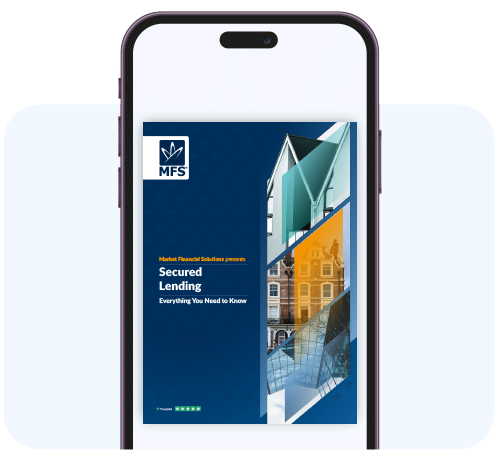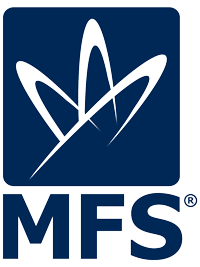The Complete Guide
- Breakdown of secured lending in the UK
- Covers key loan types
- Secured vs. unsecured lending
- Underwriting & approval processes
- Managing risk, LTVs & exit strategies
- Costs, fees & ways to boost borrowing power
Get your free Guide with additional infographics below.

The Complete Guide to Secured Lending
This guide will break down everything brokers and borrowers need to know about secured lending with a main focus on the property market. We will answer the basic questions of what is secured lending, and what’s the difference between unsecured and secured loans. We will also explore the more complicated areas such as industry-specific terminology, and the regulatory backdrop.
It’s important to understand all the details involved, given the scale of secured lending at large. In the property market, all mortgages, and a substantial number of other types of home loans, will be secured lending loans[1]. In October 2025, the outstanding value of all residential mortgage loans sits at £1,703.6bn, 2.6% higher than a year earlier[2].
Why It Matters
Market participants of all creeds need to understand the ins and outs of this – from property investors, through to brokers and lenders. With lenders, risk management will be of the utmost importance when it comes to secured lending. This is because should their secured borrowers default, they as a lender have a legal claim over the asset(s), whether it be a residential or commercial property.
For borrowers, that factor will often prove to be worthwhile. Without secured lending options, many households and businesses wouldn’t be able to access the large capital amounts that the property market demands. All told, secured lending underpins the property market, and supports continued homeownership, investment, and economic growth.
But of course, there is the risk at the other side of this equation. Property makes up a substantial proportion of a lender’s collateral, and so their performance is heavily correlated with property values. Should house prices fall sharply or unexpectedly, banks and other financial institutions could end up in trouble. This is why secured lending is constantly scrutinised, and carefully assessed.
Different Lenders, Different Approaches
While both high street banks and specialist lenders offer secured lending loans, there are a few differences in how they assess and deliver funding. With mainstream banks and building societies, secured loans often translate to mortgages, and applicants are primarily assessed on their income levels[3].
Whereas specialist lenders like Market Financial Solutions, primarily focus on the secured asset’s value. Other elements that are factored in across the board include existing debts, the strength of the wider market, and a borrower’s long-term plans.
So far, we’ve only touched on the basics. There are a lot of nuances with secured property loans, and secured business lending. We will comb through these nuances, and hopefully answer any questions or concerns that may be lingering.

What is Secured Lending?
The term “secured” simply refers to the fact that loan in question will need something as a security in the event that the loan can’t be repaid. The loan will be secured against a specific asset(s). In our industry, the secured asset will often be a property, and at Market Financial Solutions specifically, we will only accept property as a security. Some lenders however may accept cars, jewellery, or other assets as security. Where borrowers fail to cover their secured loans completely (known as defaulting) the lender involved (often as a last resort) can apply to the courts and force the selling of the security asset to get their money back.
All parties involved want to avoid a default wherever possible. Thankfully, they are relatively rare. In Q2 2025, there were only 1,340 homeowner mortgaged properties taken into possession according to UK Finance[4], significantly less than the long-term average. Meanwhile, Bank of England data shows secured lending defaults have been on the decline in recent months[5].

Types of Secured Lending
Broadly, there are four main types of secured loans in the property world. First charge mortgages, commonly known as the “main” mortgage on a property, are the primary loan secured on the asset. What this means in practice is that in the event of repossession, the first charge mortgage lender is paid off before any other parties involved[6].
Following on from this are second charge mortgages. These are funds that are secured on a property where a first charge mortgage is already in place. These loans are commonly used for home improvements, debt consolidation, or other major expenses.
Then there are bridging loans. This type of specialist finance covers a broad gamut, from straightforward purchases through to capital raises for business investments. Typically, bridging loans are used for short-term concerns such as chain breaks and auction bids.
Equity release is another type of secured lending. Here, older homeowners release cash from their homes without having to move. Most commonly, this is done via a “lifetime mortgage”, which allows people to borrow money against the value of their homes by taking out a loan secured on them. The released capital can be put towards home improvements, gifted deposits, or whatever else the borrower plans to spend it on.

Understanding Loan-to-Value & Affordability
When lenders create their secured lending loans, they do so with certain factors in mind. First and foremost, there is the loan-to-value ratio (LTV). This is a percentage figure that compares a secured property loan’s size against the asset involved. Most specialist or bridging lenders expect borrowers to have a deposit of at least 25%, meaning they’d have an LTV of 75%.
A higher LTV means more risk to lenders, which could result in tougher terms and higher costs for borrowers. Lenders will also factor debt service ratios or debt-to-income ratios. These measure the borrower’s affordability capabilities, and will be of high importance for regulated mortgage lenders.
Loans Terms & Rate Structures
The vast majority of secured loans have an initial term, the period over which the money is borrowed and repaid. Currently, first-time buyer mortgage term lengths sit around the 30-year mark[7], whereas the typical bridging loan term is around 12 months. Across Market Financial Solutions’ suite of secured lending loans, our terms range between 3 months and 25 years.
Where initial terms end, borrowers will be moved onto their lender’s standard variable rate (SVR) if they don’t manage to secure a new deal or refinance.
Generally, borrowers may try to avoid this, as SVRs tend to be expensive[8]. Secured lending options can have fixed rates, where the interest rate remains the same for an agreed period, and/or tracker rates, which follow an external economic indicator such as the Bank of England base rate.
Managing Risk & Repayments
One of the main factors influencing the rates that are available in the market is risk. This includes macro-economic risk, and borrower-specific risk. Those with adverse credit issues such as CCJs, missed payments, or defaults in their background are likely to face higher rates in the market as a result.
Also, borrowers need to assess their own risk-tolerance, and budgetary concerns. Secured loans provide access to substantial amounts of capital with plenty of time to pay it back, but the interest still accrues. Also, should borrowers want to pay off their loan faster than agreed, they may be hit by early repayment charges[9] (ERCs).

How Do Secured Loans Work iIn the UK?
Just as is the case with other types of loans, those who utilise secured loan products will make monthly repayments to pay back what is owed, plus any interest. With specialist secured lending, covering the facility is more focused around exit strategies, which typically involve selling an asset to cover the loan in full, or refinancing down the line with long-term lenders.
Specialist secured loans are generally unregulated, meaning they are more flexible than their high street counterparts, and can be delivered with more speed. Residential mortgages are regulated by the Financial Conduct Authority (FCA) whose objectives are to protect consumers, protect financial markets, and promote competition[10].
For this market specifically, the FCA has announced plans to review mortgage rules, and look for ways to modernise the industry, make it more accessible for consumers, and maintain responsible lending practices[11].

Secured vs Unsecured Lending
Put simply, a secured loan requires a security asset, whereas an unsecured loan doesn’t. Common examples of unsecured loans include student loans, personal loans, and credit card debt. As there is no security involved, eligibility for unsecured loans will depend on the applicant’s credit history[12]. Also, as there are no assets held against unsecured loans, the interest rates tend to be higher.
Unsecured loans can be turned around much quicker than secured loans. With no need for a security asset, the borrower does not risk losing their asset. Also, while the interest rates may be higher, they’ll usually remain unchanged throughout the duration of the term[13]. Unsecured loans may be suited to those with solid credit records, stable income sources, and who don’t want to risk their assets being seized.
It should be noted that unsecured loans tend to be much smaller than secured products. Lenders who offer unsecured loans may have limits of £25,000[14]. This level of funding may only be able to be put to use in the property market for refurbishments or smaller end-goals. It’s highly unlikely that they’ll be able to be put towards a property purchase.
The unsecured lending market, or at least specific industries within it, is under increased scrutiny from the regulator. The FCA has recently published details on its plans to regulate the £13bn buy now, pay later (BNPL) market[15].
Moreover, the recent motor finance scandal[16] has opened up the door for similar customers to be eligible for compensation, according to a government research briefing on consumer credit[17]. The perceived advantages of unsecured lending – speed and flexibility – may carry less weight in the months and years ahead.
Benefits of Secured Lending
Secured lending brings with it several benefits for property investors. For starters, it allows for higher borrowing capacities when compared to unsecured lending options. Unsecured loans present more risk to lenders and as such, they’re generally smaller. Whereas with secured loans such as mortgages, there is less risk so lenders can offer much more in capital.
It may also be easier to get a secured loan with a spotty financial history over an unsecured loan. While lenders will have different preferences and risk tolerances, the added element of a secured asset may even out the risk that comes with borrowers who have missed payments or CCJs on their records.
Also, secured loans may have broader eligibility for those with relatively unique backgrounds. Examples include the self-employed, and those with complex income sources.
Then there are the terms. Generally, secured loan interest rates are lower than their unsecured counterparts. Again, this reflects the reduced risk associated with them from a lender’s perspective. Furthermore, with secured loans, borrowers typically have longer periods to cover that interest, and repay the loan. Making regular repayments over a long period can also boost one’s credit score.
Secured loans may also come with flexible repayment options that can help with affordability. At Market Financial Solutions for example, we can utilise rolled-up interest, deferred interest, and top-slicing across our product range.

Considerations
While secured lending brings with it several benefits for borrowers, especially property investors, there are potential drawbacks that must be taken into account. Chiefly, there is the repossession risk.
If payments aren’t made on time, borrowers are at risk of having their securities repossessed. Of course, throughout the assessment process, both the borrower and lender involved will make sure this is avoided as much as possible.
But unexpected surprises can always arise, so borrowers need to do everything they can to make sure their plans don’t derail. To aid with this, we have free-to-use calculators on our site to help borrowers pre-budget for their real estate secured lending plans.
Also, missing loan payments can affect a borrower’s credit score. Missed payments can stay on a record for years, which can affect future finance applications.
Borrowers also need to be mindful of costs. While secured rates may be relatively low, there are additional fees and charges which may catch them off guard. This can include arrangement fees, broker fees, and early repayment charges.
Some brokers argue that certain fees and charges can be hidden during the application process[18], which adds to the challenges. Fortunately, as we underwrite from day one of an application, our brokers and borrowers will never be caught by surprise.
Also, it takes more time to deliver secured lending loans. A typical mortgage application can take up to four weeks just to process and receive a mortgage offer[19]. Brokers and borrowers need to factor in this time with their long-term plans in mind.
In the specialist market however, secured loans can generally be issued very quickly. Where everything lines up in the underwriting process, Market Financial Solutions can have funding delivered in mere days where required.
Security limitations may also be an issue for some. While some lenders may allow for asset-based secured lending, whereby assets such as cars and artwork are used for security, they may be few and far between.
Most borrowers in our market will end up needing to use property assets as their securities, even if they’d rather not. At Market Financial Solutions, we only accept property assets for our loans.

What Can a Secured Loan Be Used For?
Secured loans can be used for all manner of property investments, the most obvious being purchases. A secured loan can be used to purchase various residential, Buy-to-Let, commercial, and/or mixed-use properties. This can range from basic flats through to shopping centres. These purchases can also come via auction bids, repossession sales, and other niche methods.
Secured loans can also be used for property development projects. While we do not offer ground-up development finance at Market Financial Solutions, we can provide development exit loans for those who are coming to the end of a project and who need more breathing space.
Moreover, our loans can be used for various refurbishment, conversion, or renovation plans as well as refinancing strategies.
In our market, specialist secured loan applications are being driven by property developers and investors[20]. Specifically, bridging loans are being used by many borrowers for refurbishment plans to meet looming EPC requirements. Also, auction bidders are turning to bridging loans to secure opportunities quickly.
On opportunities, borrowers also continue to use bridging loans to avoid losing properties when a chain breaks. A bridging loan can keep an investment afloat while options are found for the long-term. Considering that as many as 60% of homeowners have been involved in a property chain when purchasing a home[21], chain breaks are likely to continue to be a key concern for bridging lenders and brokers.
While many brokers and borrowers may only think of property investments when it comes to secured loans, they can be used for other purposes. So long as the loan is secured against a property (or another asset a lender accepts) it can be used for many business-related end goals. This can include debt consolidations, business expansions, cashflow management, and more.
What unites all these options in the specialist lending market is the exit strategy. Regardless of what the loan will be used for, the exit strategy needs to be clear, and evidenced from the outset. At Markt Financial Solutions, we work with each client to establish a clear exit strategy before releasing funds, giving everyone confidence in a secure outcome. Common examples include the sale of an asset, long-term refinancing, or other evidenced options.
Types of Secured Loans
In our market, secured lending will largely concern property-backed loans. As mentioned, this primarily includes regulated mortgages, and unregulated specialist loans.
First charge mortgages are the main mortgage on a property, and take priority over all other concerns. When we refer to the main mortgage, we’re talking about the original loan that’s used to purchase the underlying property. But, remortgages and even further advances can be considered a first charge loan.
A remortgage is when a person refinances their main mortgage with a new loan. The new mortgage replaces their original one, and hence becomes the first charge loan. This is typically done when a person comes to the end of a term, or seeks out a better deal.
A further advance is where a person raises additional funds with their existing lender. While technically separate from the existing mortgage, it can still be considered a first charge as it’s with the original lender[22].
Outside of the “main” mortgage arena, there are bridging loans. They can be used for chain breaks, refurbishments, and auctions. But at Market Financial Solutions, we also have secured products designed specifically for those with bad credit, limited companies, trusts, OpCo/PropCos, first-time buyers, first-time landlords and more.
It should be noted that secured bridging loans can come in two main formats: regulated and unregulated. We only provide unregulated bridging finance. This means the funds can only be used for investment purposes.
But some lenders may offer regulated bridging loans, whereby the security involved is being lived in by the borrower, or their immediate family members. These loans must follow FCA consumer protection rules, and are likely to adhere to more stringent lending criteria.
However, the regulated bridging market is much smaller than the unregulated market. To illustrate, the total loan value of the regulated bridging market in 2023 was just over £1,425bn[23]. In Q1 2024 alone, unregulated bridging loan books at large sat at £8.1bn[24].
Secured lending can also come in the form of business loans. Here, money is borrowed to expand a business’s ventures, but it may not be secured against property. Instead, it can be secured against other assets such as machinery, or vehicles[25].
More niche forms of secured lending include cash secured loans, and peer-to-peer loans. Cash secured loans may be offered to those who have a lot of cash deposited in fixed term savings account, but require short term liquidity[26]. Some lenders may be willing to offer a loan for a short-term purpose, using that locked away cash as security.
Peer-to-peer loans are often unsecured, but they can come in secured formats[27]. It allows people, or entities to lend directly to individuals or small business, cutting out the need for a third-party lender entirely. While it has the word “lending” in it, peer-to-peer lending can actually be considered an investment in its own right, and therefore comes with its own risks. They can be secured against properties, business invoices, and other types of assets.

Borrowing Power & Loan-to-Value (LTV)
How much a person can borrow will depend on a combination of their circumstances and those of the lender. From a lender’s perspective, they’ll want to limit their secured lending concentration risk as much as possible[28].
Concentration risk occurs where a lender approves a secured loan on too many properties in the same area or development. On a narrower scale, concentration risk can also involve how much money is lent to an individual borrower.
Should a lender’s loan portfolio be concentrated in one area (say secured residential loans in a singular town) and that area suffers a downturn, it could lead to substantial losses. As such, lenders may limit how much exposure they have to a specific market.
Specialist lenders usually also need to adhere to their funding line mandates. They often rely on wholesale or institutional funding lines. These lines allow larger institutions to access a niche market they don’t serve directly.
But, they often come with limitations. Some institutions may only want their capital invested in the commercial property market, or they may impose maximums for singular loans. This in turn can limit how a specialist lender delivers funding for property investors.
The size of secured lending facilities can also have an effect. Larger loans can tie up liquidity for a lender. This may limit their ability to fund other deals, at least in the short-term.
On the borrower’s side, their borrowing capabilities will primarily be driven by loan-to-value (LTV) ratios. The LTV ratio compares the amount of money borrowed against the property value. It’s presented as a percentage, and the higher it is, the greater the risk for lenders.
More risk translates to higher costs and tougher terms, and most lenders will place limits on how high LTVs can be. At Market Financial Solutions, most of our products go up to 75% LTV.
Boosting Affordability with ICR Tools
While LTV is the primary driver of secured lending, there are auxiliary tools that can help with repayment affordability. This revolves around the interest coverage ratio (ICR) which is used mainly for BTL investments.
It gauges whether a borrower can meet their debt obligations, and it’s also expressed as a percentage. While it is used for landlords investing in the BTL market, it can also be used by companies when they’re utilising secured business loans.
For landlords, the ICR lays out the portion of the gross rental income required to cover loan repayments, taxes, and other costs. This calculation allows lenders to determine if borrowers can afford the repayments on their secured lending facility.
The specific ICR formula is as follows: ICR = EBIT (earnings before interest and taxes) / interest expense. The result is then multiplied by 100 to get a percentage. Most lenders will set ICRs of between 125% and 145% for their secured loans[29].
At Market Financial Solutions, our secured lending borrowers can boost their loan size with various repayment tools at their disposal, so long as the resulting ICR is 125% or higher. This includes rolling up the interest, meaning borrowers pay nothing at the start for one to nine months, and any accrued interest during that time is paid at the loan’s redemption. This helps borrowers progress with their plans, while allowing us to boost the ICR as we compare the remaining months of interest against 24 months of rent.
Deferred interest is another option that allows our borrowers to deduct up to 2% from their rate, and any interest accrued during the term is paid at redemption. This cuts monthly interest payments, and boost the ICR as we compare the cut payment to the rent.
Also, there’s top slicing. We can allow BTL borrowers to utilise their surplus salary, savings, additional rent revenues from other properties, or other forms of liquid funds to “boost” their rental income. Of course, the underwriters involved will work closely with our brokers and borrowers to determine if any of these options are right for their circumstances.
To help with this, we have secured lending calculators on our site that can allow users to see how these ICR boosting tools could work with their circumstances. From here, our underwriters can be contacted directly to discuss next steps.

The Application & Underwriting Process
Secured lending application processes will vary between lenders. However, most will follow a similar pattern. To start with, every lender will need to be contacted with an enquiry, or application. These days, this will be done online, via email, or over the phone.
With this enquiry, the broker (or borrower if they’re applying directly) will need to break down the amount of finance they’re after, what it’ll be put towards, and other key details. Lenders need certain documents to get the ball rolling, such as ID documents, proof of employment/income, bank statements etc.
From here, the underwriting process can begin. To start with, lenders will usually kick off with credit checks once they have verified the borrowers’ details. This will then be followed by a valuation of the security property, to ensure it’s suitable for the loan at hand. Once all the figures are collated, LTV calculations are made and should everything be accepted, a loan offer is produced.
This offer breaks down all the terms and conditions. If they’re accepted the agreement is signed, and the lender registers their charge against the security. Throughout, legal teams will ensure everything goes through the books properly, and the funding is delivered for drawdown.
This is a simplified version of the process but at Market Financial Solutions, we follow a very similar structure. With our bridging loans and buy-to-let mortgages, we can receive an enquiry online, via email, over the phone, or through our live chat.
We respond to all enquiries within four hours, and indicative terms are provided from the get-go, allowing for full transparency from the start. These terms outline an agreed rate, and loan value.
Every one of our deals will have an assigned underwriter from day one, who will work to get a decision in principle issued as soon as possible. This will involve a more in-depth analysis of the borrower and their circumstances, including “know your client” searches. Some examples of the documents we’ll require for this can include proof of residency, three months’ worth of bank statements, and a property portfolio schedule.
Once the underwriter gathers what they need, valuers will be instructed to visit the security property. This will allow us to confirm the details in the DIP. Following this, the lawyers involved will do all the necessary work from their end to help both us and the borrower progress the case. This may include gathering all the relevant information on charges, deeds, priority notices, and more.
Finally, we deliver the funding for drawdown, with the whole process being wrapped up in just a few days where everything lines up. Throughout all this, the underwriter will keep the broker and borrower in the loop with open communication lines.
Timelines for all this will also vary. However, a regulated mortgage application to an offer typically takes between two to four weeks[30]. Also, while we can have funding delivered in mere days, many of our cases are resolved in a few weeks. Generally, the more complicated the circumstance, the longer it takes for capital to be released.

Lender Perspective: How Decisions Are Made
Secured lending practices are largely governed by risk modelling. In the simplest terms, lenders use credit risk modelling to assess the likelihood that they’ll be repaid. It helps quantify the likelihood of a borrower defaulting on a loan, and estimates potential financial losses.
In the specialist lending market, there are four key decision drivers behind this modelling. We factor in the security asset, the borrower’s circumstances, the exit strategy, and the underlying numbers (income, portfolio size etc.).
In the broader secured lending market, banks and investment firms must also adhere to capital adequacy requirements[31]. These rules stipulate that financial institutions should have, and be seen to have, a certain amount of capital relative to the amount of business which they undertake and the commercial risk associated with that business. Banks and investment firms that are regulated by the FCA and Prudential Regulation Authority (PRA) must have specific ratios of capital in comparison to the amount of their assets.
Lenders will also be swayed by the default recovery process. While defaulting on a loan is largely a borrower concern, the process can still raise challenges for the lender itself. All the parties involved will want to avoid it.
Where defaults occur, lenders will need to enter a recovery and enforcement process[32]. This process must be carefully managed to ensure compliance with the terms of the loans they issued, and the law.
Lenders must ensure they follow the correct procedures so as to avoid any costly legal challenges, act fairly and reasonably by doing such things as providing adequate notices, and mitigate losses. On the latter, they can appoint a receiver to manage the underlying property or attempt to sell it at the best possible price.
From a commercial perspective, some lenders may prefer to only operate in liquid markets that can lead to easier decision making. Many may only choose to work in London where there are predictable levels of demand. Others may opt to solely lend on residential properties which pose less risk. Regardless, all secured loan lenders should make it clear from the beginning what they’re willing to lend on, and what their terms are.

Secured Lending Costs Beyond Interest
With secured lending loans, borrowers will rightfully be concerned with the interest rates involved. But, they must not lose sight of the other costs that are associated with property loans, and mortgages specifically.
There are the primary mortgage fees which need to be taken into account. This includes an arrangement fee, booking fee, valuation fee, and various legal costs. According to the HomeOwners Alliance[33], these kinds of fees can range from £25 to several thousands of pounds.
Brokers also have their own commissions and fees. Some will expect upfront payments from their customers before they begin their search for deals. These fees can range anywhere between £300 to £600[34]. Also, most mortgage lenders will pay brokers a commission of about 0.35% of the loan size[35].
While this doesn’t primarily concern the underlying borrower, it can still affect them. Brokers may have a preference to work with lenders who pay higher commissions. Also, some lenders may factor their commissions (often called procuration fees) into their product’s rates.
Exit fees, and early repayment charges also need to be kept an eye on. A borrower may incur an exit fee when they reach the end of their secured lending product’s original term, or remortgage with a different lender[36].
Meanwhile, an early repayment charge may be levied when a borrower pays off their loan before the current deal ends, or makes an overpayment that takes them over an agreed overpayment allowance.
An exit fee can range between £75 and £300, whereas an early repayment charge can be up to 5% of the loan amount[37]. All told, Zoopla details it is “sensible” to keep around 15% of the value of a property aside for any additional buying costs[38].
In October 2025, the average UK house price is £270,000, according to the ONS[39]. This means a typical buyer may want to dedicate around £40,000 to cover any applicable costs.

Secured Lending Case Scenarios
Secured property loans, and secured business loans can keep many investment plans afloat when things turn sideways. This is true even of the most standard investments.
Chain Breaks
Take a residential purchase. A property investor plans to purchase a £750,000 BTL property in a prime commuter location. Their mortgage is already arranged with a high street lender, and an offer is in place. However, the seller is in a chain, and a shift in circumstance arises where it becomes clear they need to complete quickly, or risk the chain collapsing. Our borrower is aware of the issue, yet their long-term mortgage lender cannot complete until the chain is re-established and all standard checks are redone, a process that could take several weeks
Thankfully, a secured bridging loan could help here. Rather than lose the property, the investor could turn to us for a bespoke loan to complete the purchase immediately. Our facility could be arranged in a matter of days, allowing the buyer to secure the property while the rest of the chain recovers, or until their long-term BTL mortgage is ready to complete. To help manage cash flow during the short-term period, the investor could roll up interest payments and settle them when they exit the bridge. Once the new mortgage completes, they could refinance seamlessly, repaying our facility in full. With this approach, the investor avoids missing out on a valuable opportunity.
Niche-Investments
Secured lending is also there for commercial investors who may be held back by industry-specific challenges. For a pertinent example, we’re seeing rising demand for owner-occupied care homes[40], but these can be hard to accommodate.
This kind of commercial investment and setup would require a lot of due diligence. From a lending perspective, we’d have to make sure everything lined up perfectly before we could progress. Much of this would depend on the exit strategy and even if the underlying borrower had many available, we’d still have to move forward with caution.
Many borrowers investing in this space have faced a tough few years. A typical investor is unlikely to have particularly good accounts, most likely due to Covid-19 related difficulties. As such, we’d likely need evidenced back up exit strategies, while we could also lend against the bricks and mortar value of the property. If we were to also take into account the trading value, the LTV on this kind of deal could be quite low, which would make us more comfortable in delivering the tailored funding required.
With this kind of specific commercial investment, we’d look out for unique exit options. These kinds of sites can include multiple plots of unused land. If the borrower plans to work with developers to sell or utilise this land, that would make a great exit strategy for our secured property loan.
Development Exit
Another tricky scenario that tailored secured lending can help with is a development exit. Many of the challenges of a development occur towards the end of a project[41]. Thankfully, we can provide a bit of breathing space when these late-stage issues arise.
In recent years, we’ve seen many developments delayed by a lack of power capacity in the National Grid[42]. Developers, through no fault of their own, are hit by surprise costs as they suddenly need to source portable generators, or temporary connections. Added expense is the last thing they need when budgets are spread thin as is.
In finding solutions for this power dilemma, it may leave a borrower completing on a 12-month development plan in month 11. This doesn’t leave much time left over for selling new units. Fortunately, one of our secured development exit bridging loans could provide them with another 12 months of breathing space to effectively market and sell the properties, and avoid selling at a loss in order to meet a looming deadline.

FAQs
Are secured loans cheaper?
Ultimately, the answer to this question is: it depends. The costs involved will almost entirely depend on the borrower’s circumstances. Broadly though, the average interest rate on secured loans can vary between 2% and 10%, while with unsecured loans the rates may be between 6% and 25%[43]. Also, with secured lending, repayments are typically spread out over longer periods, which can make them more affordable.
Do secured loans affect credit score?
Yes, applications for secured lending loans are most likely to affect a borrower’s credit score, even if only temporarily.
Can I repay early?
Borrowers will be able to repay most forms of secured lending early, but this is likely to trigger early repayment charges, and/or exit fees. Borrowers need to ensure any decision made is right for their circumstances.
What happens in default?
When a person defaults on a secured lending loan, the lender(s) involved have the legal right to take possession of the security properties. Although, borrowers may be able to negotiate an agreement with their lenders by contacting them as soon as they realise they’re struggling to meet their payments[44]. Defaults will usually be recorded on a credit report, which will make it harder to access capital in the future.
Is secured lending only for property investments?
No, on top of real estate secured lending, there is secured business lending that can be put towards a range of business plans. Secured lending can also help with debt consolidation, or perhaps even large purchases such as a boat or car.
Can foreign nationals get secured loans in the UK?
Generally, yes. Although lenders will have their own preferences on who they lend to. Foreign national borrowers present additional risk for lenders, and so they may have tougher criteria for them, or they may not serve them at all. At Market Financial Solutions, almost all our loans can be utilised by foreign nationals from any country, other than those that are sanctioned or blacklisted.
Are secured loans regulated?
It depends on the loan one is applying for. A residential mortgage will be regulated, whereas an investment bridging loan will likely be unregulated. At Market Financial Solutions, all of our products are unregulated.
How do lenders treat offshore companies?
Offshore companies present higher risks for lenders. As such, they’re likely to impose enhanced due diligence (EDD) on them. This involves more rigorous risk assessments, and will likely lead to higher costs and tougher terms. Some lenders may not be willing to lend to offshore companies, and so brokers and borrowers will need to ensure they find the right lender for their circumstances.
The Future of Secured Lending in the UK
Secured lending, and the specialist market specifically, is set to grow over the coming years. The bridging market has maintained strong momentum throughout 2025, and lenders continue to break records. The latest data from the Bridging & Development Lenders Association[45] showed new bridging loan completions totalled £2.8 billion in Q1 2025, matching the record set in Q4 2024.
At the same time, new applications surged to £18.34 billion, a 55.3% increase on the previous quarter. Loan books have also “swelled” to just under £13bn.
Looking ahead, it seems that AI and other technologies will be at the forefront of change over the coming months. As secured lenders look for better ways to service their clients, AI and intelligent automation investment may help streamline processes, and speed up the process[46].
Secured lenders will need to do everything they can to optimise their services given that they’re under increased regulatory scrutiny. The FCA recently launched the next phase of its Mortgage Rule Review, publishing a discussion paper aimed at encouraging open dialogue on the future of the UK’s mortgage market[47]. This paper aims to help the FCA assess the changes needed to support sustainable home ownership and wider growth.
Having said that, other updates from the regulatory environment indicate that certain rules may be loosened to relieve the “excessive burdens” levied on financial service providers. Nikhil Rathi, chief executive of the FCA, revealed he was planning to change consumer duty rules introduced two years ago, following complaints from companies who said they were too heavy-handed[48]. Both lenders and their clients will need to keep an eye on how the regulatory environment evolves this year and beyond.
Secured lenders are also likely to be swayed by the market’s movements over the coming months and years with many new regulations waiting to be introduced. All this will impact how landlords and property investors proceed, and lenders will be forced to adapt.

Conclusion
Secured lending plays a foundational role in unlocking economic opportunity, and driving growth. It allows individuals and business to utilise their assets as collateral to access funding. This transforms somewhat illiquid assets into working capital that goes towards further investments, expansion, innovation and ultimately, drives economic growth.
Without secured lending, there would simply be no way for many people to own their homes, or reap the rewards of property investment. The ramifications of this results in job creation, regional developments, and even the support of family structures.
We understand just how important the secured lending scene is for our country’s prosperity, which is why we do everything we can to position ourselves as a market leading bespoke lender.
Since our founding in 2006, we have strived to deliver flexible finance rapidly for residential and commercial property investors. We understand that no two deals are ever the same, which is why we don’t have a tick-box lending criteria, and all our deals are underwritten from day one.
What’s more, we are there for property investors who may struggle to attain secured lending loans on the high street. We are happy to hear from those who may have missed payments in their backgrounds, who are investing via a unique setup, or who may be purchasing from overseas.
We are ready to handle any queries that come our way. Our phone lines are open, and our live chat is manned by a human – not a chatbot. Contact us today, if you have any enquiries or questions.
Secured Lending Glossary
- Affordability test: a lender’s assessment of whether a borrower will be able to repay a loan
- Asset backed loan: a secured loan whereby the security is more likely to be a non-property asset. Examples include vehicles, company equipment, or artwork
- CCJ: a county court judgement is a court order made against someone when they have failed to pay a debt. Having a CCJ on one’s record can make it difficult to attain finance in the future
- Deferred interest: where interest payments are postponed for a set period, usually under the condition that the entire balance is paid at the end of a term
- ERC: early repayment charges are penalties levied by lenders when a borrower repays all, or part of a loan before an agreed-upon deal period ends
- Exit strategy: the plan a borrower puts in place to repay their secured loan. Exit strategies primarily concern bridging loans, buy-to-let mortgages and other bespoke products
- FCA: the Financial Conduct Authority is the independent body that regulates financial services firms
- First charge mortgage: the primary loan secured against a property
- LTV: the loan-to-value ratio is a percentage figure that compares a secured property loan’s size against the asset involved
- Rolled up interest: where unpaid interest is added to a principal loan balance, instead of being paid in regular monthly instalments
- Second charge mortgage: a loan secured on a property where a first charge mortgage is already in place
- Secured loan: a loan which is secured against an asset. Usually this is a property but can also include artwork or business machinery
- SVR: a standard variable rate is the interest rate charged when an initial loan deal comes to an end
- Term: the length of time that a borrower has to repay their mortgage/secured loan
- Unsecured loan: commonly known as personal loans; these are products that aren’t backed by any security
[1] https://www.hsbc.co.uk/loans/secured-vs-unsecured-loans-explained/
[2] https://www.fca.org.uk/data/mortgage-lending-statistics
[3] https://www.onlinemortgageadvisor.co.uk/mortgage-affordability/mortgage-affordability-checks/
[4] https://www.ukfinance.org.uk/data-and-research/data/arrears-and-possessions
[5] https://www.bankofengland.co.uk/credit-conditions-survey/2025/2025-q2
[6] https://www.charcol.co.uk/mortgages/specialist-mortgages/second-charge-mortgages/first-charge-and-second-charge/
[7] https://www.bbc.co.uk/news/articles/c5y547vq9z1o
[8] https://hoa.org.uk/advice/guides-for-homeowners/for-owners/standard-variable-rate-mortgage/
[9] https://www.experian.co.uk/consumer/loans/types/secured-loans.html
[10] https://www.fca.org.uk/publications/corporate-documents/our-approach-consumers#:~:text=Our%20objectives,-We%20have%20a&text=protect%20consumers%20%E2%80%93%20we%20secure%20an,in%20the%20interests%20of%20consumers
[11] https://www.grantthornton.co.uk/insights/fca-mortgage-rules-review-simplifying-the-mortgage-market/
[12] https://www.lloydsbank.com/loans/help-and-guidance/secured-vs-unsecured-loans.html
[13] https://www.moneysupermarket.com/loans/unsecured-loans-vs-secured-loans/
[14] https://www.loanswarehouse.co.uk/personal-loans/how-much-can-i-borrow-on-an-unsecured-loan
[15] https://www.theguardian.com/business/2025/jul/18/buy-now-pay-later-regulation-fca-affordability-checks
[16] https://www.reuters.com/sustainability/uk-motor-finance-industry-faces-11-13-bln-redress-scheme-under-regulators-plans-2025-10-07/
[17] https://researchbriefings.files.parliament.uk/documents/CBP-10328/CBP-10328.pdf
[18] https://www.thesun.co.uk/money/34639247/mortgage-rates-falling-hidden-fees-high-costs/
[19] https://hoa.org.uk/advice/guides-for-homeowners/i-am-buying/long-take-get-mortgage/
[20] https://bridgingloandirectory.co.uk/guides/uk-bridging-market-trends-2025-lower-rates-rising-applications-what-it-means-for-you/
[21] https://www.mpamag.com/uk/mortgage-types/specialist-finance/property-chain-delays-continue-to-hinder-housing-market/551712
[22] https://www.charcol.co.uk/mortgages/specialist-mortgages/second-charge-mortgages/first-charge-and-second-charge/
[23] https://www.fca.org.uk/freedom-information/information-regulated-bridging-short-term-loans-january-2025
[24] https://thebdla.org/news/bridging-loan-books-break-through-8bn/#:~:text=Bridging%20loan%20books%20hit%20another,finance%20continues%20to%20be%20strong.
[25] https://www.money.co.uk/business/business-loans/secured-business-loans#:~:text=What%20is%20a%20secured%20business,terms%20compared%20to%20unsecured%20loans.
[26] https://www.coutts.com/content/dam/rbs-coutts/coutts-com/Files/private-banking/borrowing/personal-cash-backed-lending-factsheet.pdf
[27] https://www.moneysupermarket.com/investments/peer-to-peer-lending/
[28] https://www.hsbc.co.uk/mortgages/what-is-concentration-risk/
[29] https://www.totallandlordinsurance.co.uk/knowledge-centre/ultimate-landlord-guide-to-buy-to-let-mortgages
[30] https://hoa.org.uk/advice/guides-for-homeowners/i-am-buying/long-take-get-mortgage/#:~:text=A%20mortgage%20application%20typically%20takes,a%20mortgage%20to%20be%20approved.
[31] https://uk.practicallaw.thomsonreuters.com/Glossary/UKPracticalLaw/I3f4a1c93e8db11e398db8b09b4f043e0?transitionType=Default&contextData=(sc.Default)&firstPage=true
[32] https://blackstonesolicitorsltd.co.uk/property-finance/advice-on-the-recoveries-and-enforcement-process-against-defaulting-borrowers/
[33] https://hoa.org.uk/advice/guides-for-homeowners/i-am-buying/mortgage-fees-and-costs/#:~:text=You’ll%20usually%20have%20the,go%20ahead%20with%20the%20mortgage
[34] https://www.onlinemortgageadvisor.co.uk/mortgage-broker/mortgage-broker-charges/#do-mortgage-brokers-charge-a-fee
[35] https://www.unbiased.co.uk/discover/mortgages-property/buying-a-home/mortgage-broker-fees
[36] https://www.onlinemortgageadvisor.co.uk/blog/what-is-a-mortgage-exit-fee/
[37] https://hoa.org.uk/advice/guides-for-homeowners/i-am-buying/mortgage-fees-and-costs/#:~:text=You’ll%20usually%20have%20the,go%20ahead%20with%20the%20mortgage
[38] https://www.zoopla.co.uk/discover/buying/buying-costs/
[39] https://www.ons.gov.uk/economy/inflationandpriceindices/bulletins/privaterentandhousepricesuk/september2025
[40] https://www.mfsuk.com/case-study/no-need-to-hold-back/
[41] https://www.mfsuk.com/case-study/infrastructural-issues/
[42] https://www.developmentfinancetoday.co.uk/article-desc-10228_Power%20constraints%20cause%20delays%20for%20one-third%20of%20developers
[43] https://abcfinance.co.uk/secured-loans/secured-vs-unsecured-loans/?utm_source=chatgpt.com
[44] https://www.experian.co.uk/consumer/loans/types/secured-loans.html#:~:text=What%20happens%20if%20I%20default,a%20secured%20and%20unsecured%20loan?
[45] https://thebdla.org/news/bridging-market-maintains-momentum-in-2025/
[46] https://www.ukfinance.org.uk/news-and-insight/blog/breaking-mortgage-bottleneck-how-ai-transforming-uk-lending
[47] https://financialregulation.linklaters.com/post/102kqtb/striking-a-new-balance-for-mortgage-lending-fcas-mortgage-rule-review
[48] https://www.ft.com/content/5520aeb2-2145-49b0-8882-6a0a1751086e
Market Financial Solutions are a bridging loan and buy-to-let mortgage provider and are not legal, financial, investment or tax advisers. This document is for informational purposes only and does not, and should not be considered, to constitute legal, financial, investment or tax advice or be relied upon by any person to make a legal, financial, investment or tax decision. Therefore, Investors are encouraged to seek appropriate professional advice. The information in this content is correct at time of writing.
